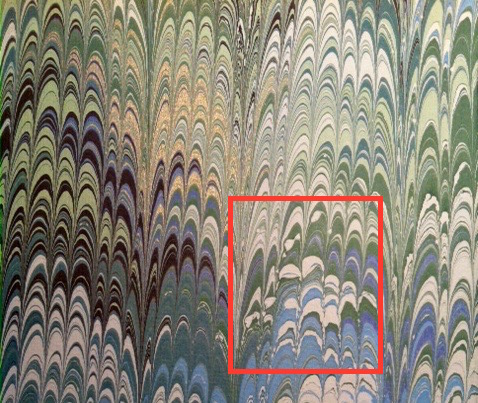Some time ago I did a note on “New Tank, What is it?” The bottom line as I understood it then was that it was something that you had to endure — it would go away when the chemicals “married.” Well, thanks to the scholarship of the Chena River Marblers I can report a way to side step this problem totally! They found this tip in one of the few books written about marbling in the 17th century and shared it in a class I was in.
The trick is to completely cover the surface of your tank with color. Originally I was taught to “flood” the tank meaning to put down a large number of drops on one color to start. This takes that kind of flooding to a new level. Start by making a row of drops down the middle of the tank — make sure, however, that each drop you put down is within the last drop you made. Here is a picture of my tanks after that row of drops down the center using white paint.
Next put a row of paint down each side of the middle row, again making sure that the drops are inside the drops in the center row of drops. It doesn’t matter how far inside, just that they are inside. In the picture below you can see the newest row (the lighter color drops) and that they are well within the first set of middle drops because you can see the edge of those drops at the top of the picture. Now your tank would like like this:
Finally, take a strip of paper like you use to clean the tank and put one edge of it inside the edge of the paint on one side of the tank. Pull the paper to the edge of the tank and then up the side and out of the tank. That action will bring the paint right to the edge of the tank. Also, pull the paint to the edge of the other side of the tank. The point is to make sure that the paint covers the entire surface of the tank. If the paint pulls away or your newspaper strip wasn’t long enough just use another strip to make sure the paint is spread all over the tank surface.
 That’s it, and it works! You can go forward from there dropping paint as you would normally. Another helpful tip is to use darker colors of paint when the tank is new and clean because it is easier to see. If your tank is dirty/darker color, then use a lighter paint. With experience you will be able to see even white paint on a clean tank but it will probably take so time.
That’s it, and it works! You can go forward from there dropping paint as you would normally. Another helpful tip is to use darker colors of paint when the tank is new and clean because it is easier to see. If your tank is dirty/darker color, then use a lighter paint. With experience you will be able to see even white paint on a clean tank but it will probably take so time.

